The writer is very fast, professional and responded to the review request fast also. Thank you.
President Lincoln's main goal in the Civil War was to
eliminate slavery in all territory controlled by the United States.
a. true
b. false
Both the Union and the Confederacy used African American
soldiers during the Civil War.
a. true
b. false
A series of Union victories in late 1864 helped Abraham
Lincoln win reelection.
a. true
b. false
During his march from Atlanta to the sea, Sherman and his
men destroyed anything useful to the South.
a. true
b. false
General Grant imposed very harsh terms on the surrendering
Confederate soldiers at Appomattox Court House.
a. true
b. false
The federal government became more powerful than state
governments as the result of the Union victory in the Civil War.
a. true
b. false
Because the war disrupted their supply of cotton, the South
expected support from
a. France and Spain. c. France and Canada.
b. Spain and Mexico. d. Britain and France.
The North’s war plan came from a hero of the war with Mexico named
a. Winfield Scott. c. Abraham Lincoln.
b. George McClellan. d. Robert E. Lee.
What battle was named after a small church?
a. Shiloh c. Vicksburg
b. Gettysburg d. Atlanta
The bloodiest day of the entire Civil War was the Battle of
a. Shiloh. c. Richmond.
b. Antietam. d. New Orleans.
The first female army surgeon was
a. Clara Barton. c. Sally Tompkins.
b. Mary Edwards Walker. d. Dorothea Dix.
William Tecumseh Sherman's March to the Sea began in
a. Charleston, South Carolina. c. Atlanta, Georgia.
b. Richmond, Virginia. d. Baltimore, Maryland.
In the Civil War, for the first time, thousands of women served as
a. soldiers. c. generals.
b. spies. d. nurses.
"Peace Democrats" became known as
a. War Hawks. c. Copperheads.
b. Rebels. d. Radicals.
What guarantees accused individuals the right to a hearing before
being jailed?
a. bounties c. draft
b. greenbacks d. habeas corpus
What battle began when on July 1, 1863 when the Confederates
entered a town for supplies and encountered Union troops?
a. Gettysburg c. Vicksburg
b. Shiloh d. Richmond
The plan to gain control of the Mississippi River and split the
Confederacy in two was called
a. the Great Divide. c. the Anaconda Plan.
b. the Squeeze Play. d. the River Conquest.
The main goal of the North at the beginning of the war was to
a. end slavery. c. punish the South.
b. be recognized as independent. d. reunite the country.
General P.G.T. Beauregard fought against General Irvin McDowell at
a. Shiloh. c. the First Battle of Bull Run.
b. Gettysburg. d. the Second Battle of Bull Run.
The battle of the Monitor and the Merrimack was the first ever between
a. cutters. c. warships.
b. clippers. d. ironclad ships.
What April battle lasted only two days, but included some of the most
bloody fighting of the war?
a. Shiloh c. Richmond
b. Gettysburg d. Vicksburg
On January 1, 1863, President Abraham Lincoln signed the
a. Free Slave Bill. c. Emancipation Proclamation.
b. Fourteenth Amendment. d. Thirteenth Amendment.
Who pointed out to Lincoln that by casting the war as a fight against
slavery, European countries would be less likely to aid the South?
a. Frederick Douglass c. George B. McClellan
b. David Farragut d. Ulysses S. Grant
Pickett’s Charge took place during the Battle of
a. Shiloh. c. Gettysburg.
b. Chancellorsville. d. Fredericksburg.
The worst disturbance in protest of the draft laws took place in
a. Richmond, Virginia. c. Atlanta, Georgia.
b. New York City. d. Washington, D.C.
Appomattox Court House is famous because it is the site of
a. a bloody battle. c. Confederate headquarters.
b. Union headquarters. d. Robert E. Lee's surrender.
“[William is] . . . wild to be off to Virginia. He so fears that the fighting will be over before he can get there.” –Kate Stone, 1861 |
Written shortly after the attack on Fort Sumter, this excerpt from a letter by the sister of a Confederate soldier in Louisiana describes his _____ in the war. a. fear of involvement c. reluctance to fight b. eagerness to participate d. slowness to join
“. . . Sis I dont know what you think about the war but I will tell you what I think and that is the north will nevver whip the south as long as there is a man left in the south. They fight like wild devles. Ever man seems determine to loose the last drop of blood before they give up but there is no use of you and I talking about the war because we cant end it, but I dont care how soon it is stopped. Christmas will soon be here I would like to be at [home.] . . .” –John R. McClure, private in 14th Indiana Volunteers, Letter to his sister, December 19, 1862 |
According to the excerpt, Confederate soldiers _____. a. are very courageous c. give up easily b. are poor fighters d. outnumber the Union soldiers
“A cruel, crazy, mad, hopeless panic possessed them. . . . The heat was awful . . . the men were exhausted—their mouths gaped, their lips cracked and blackened with the powder of the cartridges they had bitten off in the battle, their eyes staring in frenzy.” –Representative Albert Riddle, observing the First Battle of Bull Run |
This excerpt describes _____ at the battle of First Battle of Bull Run. a. terrified observers of the battle b. courageous Confederate soldiers c. retreating Union soldiers d. civilians fleeing to Washington, DC
“No terms except unconditional and immediate surrender can be accepted.” –at the capture of Fort Donelson, February 16, 1862 |
This quotation provided a nickname for which new hero of the North? a. Ulysses S. Grant c. David Farragut b. Albert Sidney Johnson d. George McClellan
“. . . It had suddenly appeared to him that perhaps in a battle he
might run. He was forced to admit that as far as war was concerned he
knew nothing of himself. . . .
“A little panic-fear grew in his mind. As his imagination went
forward to a fight, he saw hideous possibilities. . . .”
–Stephen Crane, The Red Badge of Courage
|
The character in this excerpt is becoming afraid because he a. knows he will fight hard along with others. b. wishes he were back home. c. is uncertain about how he will react in a battle. d. is eager to get into battle.
“For my loyalty to my country I have two beautiful names—here I am called “traitor,” farther North a _____ –Elizabeth Van Lew, Richmond |
What word best fills in the blank in this quote by Elizabeth Van Lew, who secretly sent information about Confederate activities to President Lincoln? a. “teacher” c. “nurse” b. “spy” d. “conductor”
“If I could save the Union without freeing any slave, I would do it; and if I could save it by freeing all the slaves, I would do it; and if I could save it by freeing some and leaving others alone, I would also do that.” –August 1862 |
Who took this position on the issue of slavery? a. Jefferson Davis c. William Lloyd Garrison b. Abraham Lincoln d. Frederick Douglass
“. . . That on the first day of January, in the year of our Lord one thousand eight hundred and sixty-three, all persons held as slaves within any state or designated part of a state, the people whereof shall then be in rebellion against the United States, shall be then, thenceforward, and forever, free; and the Executive Government of the United States, including the military and naval authority thereof, will recognize and maintain the freedom of such persons, and will do no act or acts to repress such persons, or any of them, in any efforts they may make for their actual freedom. . . .” |
This announcement by the President of the United States is a quotation from a. the Constitution. c. the Gettysburg Address. b. the Emancipation Proclamation. d. the Thirteenth Amendment.
“. . . That on the first day of January, in the year of our Lord one thousand eight hundred and sixty-three, all persons held as slaves within any state or designated part of a state, the people whereof shall then be in rebellion against the United States, shall be then, thenceforward, and forever, free; and the Executive Government of the United States, including the military and naval authority thereof, will recognize and maintain the freedom of such persons, and will do no act or acts to repress such persons, or any of them, in any efforts they may make for their actual freedom. . . .” |
According to this excerpt, anyone holding a person enslaved after January 1, 1863, would be a. arrested and jailed. c. in rebellion against the US. b. given a fair trial. d. recognized by the government.
“[They] will make good soldiers and taking them from the enemy weakens him in the same proportion they strengthen us.” |
In this excerpt from a letter General Grant wrote to President Lincoln, to whom does “They” refer? a. Native Americans c. African Americans b. Female spies d. slaves on Southern plantations
“Does anyone wonder [why] so many women die? Grief and constant anxiety kill nearly as many women at home as men are killed on the battle-field.” –Mary Chesnut |
About what do women feel the “grief and constant anxiety” that this excerpt mentions? a. the difficulty of managing farms and taking care of families b. the exhaustion of working in factories and replacing missing male workers c. the problems of collecting supplies of food and clothing for the war effort. d. the possible death of husbands, fathers, sons, and brothers far from home
“July 29, 1864—Sleepless nights. The report is that the Yankees have left Covington for Macon, . . . to release prisoners held there. They robbed every house on the road of its provisions [supplies], sometimes taking every piece of meat, blankets and wearing apparel, silver and arms of every description. They would take silk dresses and put them under their saddles, and many other things for which they had no use. Is this the way to make us love them and their Union? Let the poor people answer [those] whom they have deprived of every mouthful of meat and of their livestock to make any! Our mills, too, they have burned, destroying an immense amount of property.” –from the diary of Dolly Sumner Lunt |
During General Sherman’s March to the Sea, described in this excerpt, the object of this destruction was _____. a. to destroy the Confederate army b. to find supplies for the Union army c. to encourage freeing the South’s slaves d. to break the South’s will to fight
“Can you imagine a fellow’s feelings about that time, to have to face thousands of muskets with a prospect of having a bullet put through you? If you can, all right; I can’t describe it. I’ve heard some say that they were not _____ going into a fight, but I think it’s all nonsense. I don’t believe there was ever a man who went into battle but was _____, more or less. Some will turn pale as a sheet, look wild and ferocious, some will be so excited that they don’t know what they are about while others will be as cool and collected as on other occasions.” –George Sargent, Union soldier |
Which word best fill in the blanks for this passage about facing battle? a. confused c. scared b. curious d. calm
“I can’t spare this man. He fights.” –President Abraham Lincoln |
This quotation refers to what formerly unpromising army officer? a. George McClellan c. William Tecumseh Sherman b. Ulysses S. Grant d. Ambrose Burnside
“. . . I need not tell the brave survivors of so many hardfought battles, who have remained steadfast to the last, that I have consented to the result from no distrust of them. But, feeling that valor and devotion could accomplish nothing that could compensate for the loss that may have attended the continuance of the contest, I determined to avoid the useless sacrifice of those whose past services have endeared them to their countrymen. . . .” –General Robert E. Lee, last order to his troops, April 9, 1865 |
Which statement best describes why Lee is surrendering? a. Further fighting could not accomplish anything useful and losses would be heavy. b. Lee was tired of fighting and the Confederate armies had suffered very heavy losses. c. The Confederate armies were weary and would not continue to fight any more. d. Ammunition and other supplies for the Confederate troops had run out and could not be replaced.
Referring to the figure, based on the time line, which of the
following events did not occur in 1863?
a. Red Cross established
b. Emancipation Proclamation issued
c. Lake Victoria discovered
d. Great Expectations published

Referring to the figure, the greatest difference between resources
of the North and South in this graph is in which category?
a. manufactured goods c. number of farms
b. exports d. population

Referring to the Fig. in Question #49, based on the graph, the South was most
nearly equal to the North in which of the following resources?
a. railroad mileage c. exports
b. number of farms d. manufactured goods
Referring to the figure, when was Manassas, or Bull Run, fought?
a. August 29–30, 1862 c. April 12–14, 1861
b. July 21, 1861 d. September 17, 1862
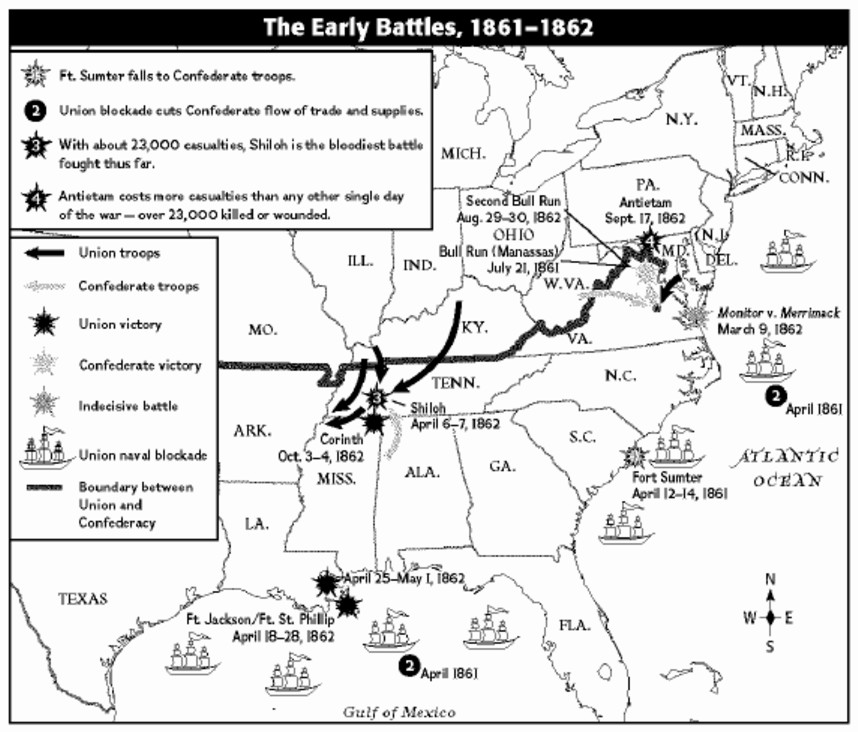
Referring to the Fig. in Question #51, based on the map, in which of the following
states were none of the early Civil War battles fought?
a. Tennessee c. North Carolina
b. Virginia d. Louisiana
Referring to the figure, based on the circle graphs, which of the
following statements is true?
a. African Americans accounted for 18% more of Union sailors than
they did Union soldiers.
b. African Americans were better represented in the Union Army than
in the Union Navy.
c. African Americans accounted for 8% more of Union sailors than they
did Union soldiers.
d. Large numbers of African Americans were pressed into service by
the Union Navy.
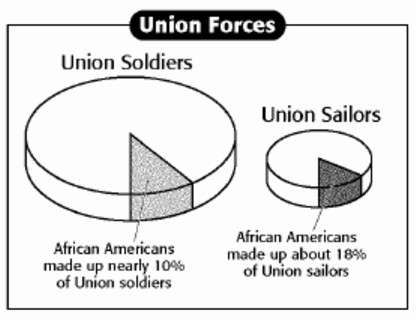
Referring to the figure, according to the map, how many victories
for the South took place in 1863?
a. 1 c. 5
b. 9 d. 4
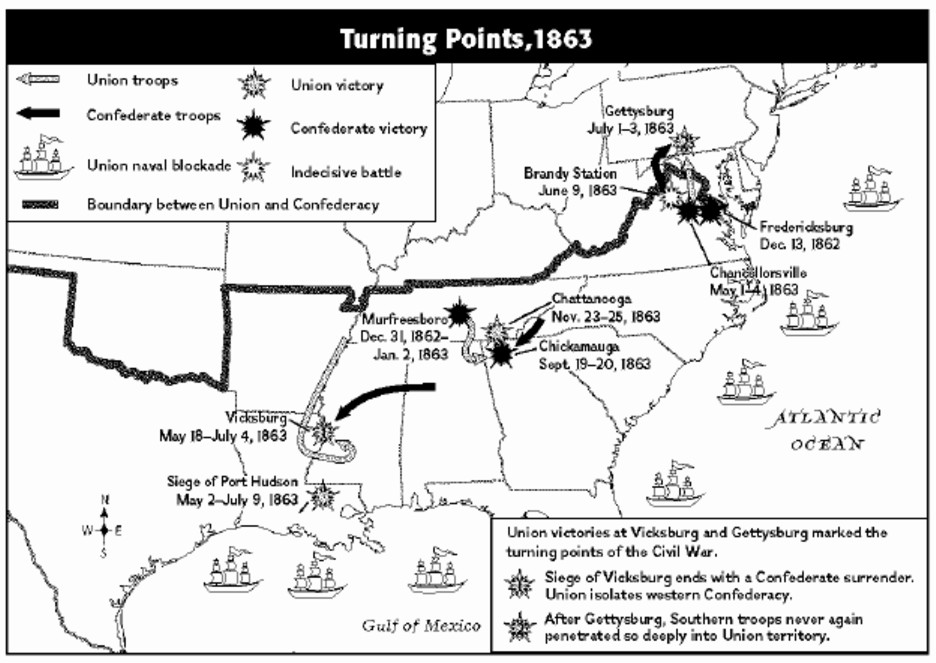
Referring to the figure, these three maps display which of the
following?
a. Union control gradually decreasing
b. Confederate control gradually decreasing
c. Union naval blockades gradually increasing
d. Union naval blockades gradually decreasing
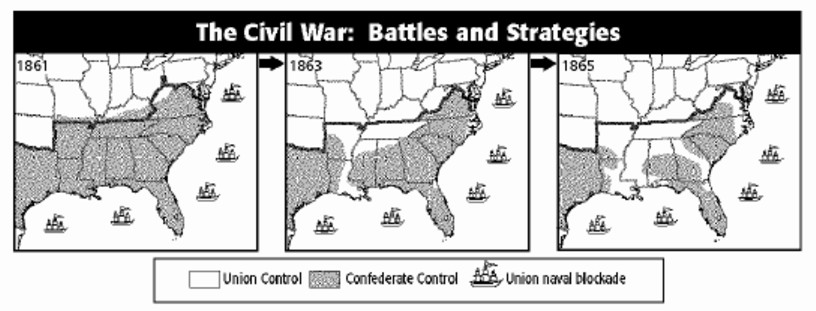
Referring to the figure, according to the circle graph, which war
cost the most American lives after the Civil War?
a. Civil War c. World War II
b. World War I d. Vietnam War
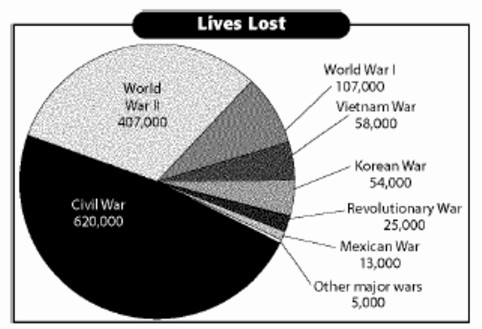
Referring to the figure, based on the map, which of the following
battles was fought on June 27, 1864?
a. Cold Harbor c. The Wilderness
b. Wilmington d. Kennesaw Mountain

Referring to the figure, the arrows on this map represent which of
the following things?
a. roads c. troop positions
b. troop movements d. Union victories
a. David Farragut d. General P.G.T. Beauregard
b. African American regiment e. blockade
c. Appomattox Court House

to close ports
a. David Farragut d. General P.G.T. Beauregard
b. African American regiment e. blockade
c. Appomattox Court House
Confederate commander
a. David Farragut d. General P.G.T. Beauregard
b. African American regiment e. blockade
c. Appomattox Court House
captured New Orleans
a. David Farragut d. General P.G.T. Beauregard
b. African American regiment e. blockade
c. Appomattox Court House
54th Massachusetts
a. David Farragut d. General P.G.T. Beauregard
b. African American regiment e. blockade
c. Appomattox Court House
site of Robert E. Lee's surrender
a. David Farragut d. General P.G.T. Beauregard
b. African American regiment e. blockade
c. Appomattox Court House
Union capital
a. Merrimack d. Washington, D.C.
b. Jefferson Davis e. Richmond, Virginia
c. Stonewall Jackson
Confederate capital
a. Merrimack d. Washington, D.C.
b. Jefferson Davis e. Richmond, Virginia
c. Stonewall Jackson
Confederate president
a. Merrimack d. Washington, D.C.
b. Jefferson Davis e. Richmond, Virginia
c. Stonewall Jackson
South's ironclad ship
a. Merrimack d. Washington, D.C.
b. Jefferson Davis e. Richmond, Virginia
c. Stonewall Jackson
casualty of Chancellorsville
a. Merrimack d. Washington, D.C.
b. Jefferson Davis e. Richmond, Virginia
c. Stonewall Jackson
total war
a. habeas corpus d. Copperheads
b. Sherman’s strategy e. Reconstruction
c. greenbacks
prisoner’s right
a. habeas corpus d. Copperheads
b. Sherman’s strategy e. Reconstruction
c. greenbacks
Peace Democrats
a. habeas corpus d. Copperheads
b. Sherman’s strategy e. Reconstruction
c. greenbacks
era after the war
a. habeas corpus d. Copperheads
b. Sherman’s strategy e. Reconstruction
c. greenbacks
Northern money
a. habeas corpus d. Copperheads
b. Sherman’s strategy e. Reconstruction
c. greenbacks
Delivering a high-quality product at a reasonable price is not enough anymore.
That’s why we have developed 5 beneficial guarantees that will make your experience with our service enjoyable, easy, and safe.
You have to be 100% sure of the quality of your product to give a money-back guarantee. This describes us perfectly. Make sure that this guarantee is totally transparent.
Read moreEach paper is composed from scratch, according to your instructions. It is then checked by our plagiarism-detection software. There is no gap where plagiarism could squeeze in.
Read moreThanks to our free revisions, there is no way for you to be unsatisfied. We will work on your paper until you are completely happy with the result.
Read moreYour email is safe, as we store it according to international data protection rules. Your bank details are secure, as we use only reliable payment systems.
Read moreBy sending us your money, you buy the service we provide. Check out our terms and conditions if you prefer business talks to be laid out in official language.
Read more